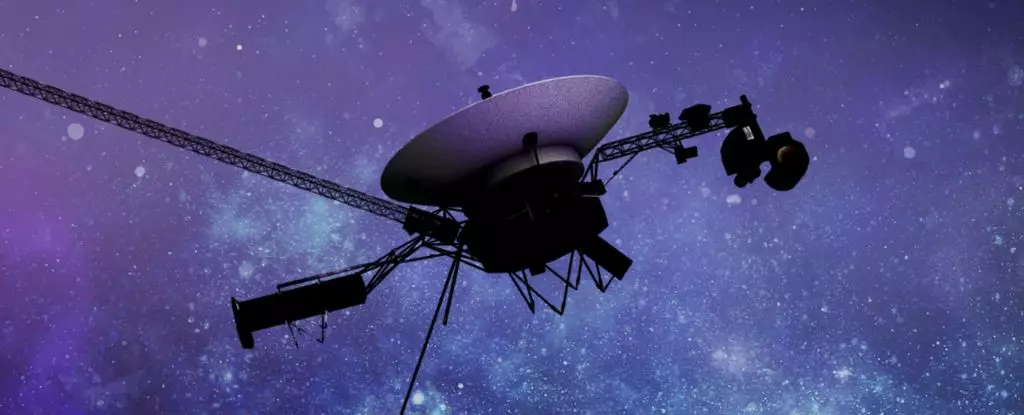In a remarkable yet concerning development last month, NASA experienced a communication lapse with Voyager 1, the most distant probe humanity has ever launched into the vast cosmos. The incident serves as a poignant reminder of the intricacies involved in maintaining interstellar communication, particularly with technology that is nearing its fifth decade of operation. Originally sent into space in 1977, Voyager 1 has been gathering data about our solar system and the interstellar medium for decades. Nevertheless, the recent hiccup highlights the challenges faced when merging aging technology with the demands of space exploration.
Moments of Uncertainty: A Heater’s Consequence
The saga began on October 16, when scientists at NASA issued a seemingly benign command to the spacecraft to activate one of its heaters. However, in a twist of irony, this simple request triggered an unforeseen cascade of issues. It took NASA two full days to detect Voyager 1’s silence, primarily due to its staggering distance of nearly 25 billion kilometers (or 15.3 billion miles) from Earth. Even signals traveling at the speed of light experience significant time delays, making instantaneous communication a near impossibility. Consequently, the two-day grace period before the communication blackout was officially recognized exemplifies the logistical challenges of interstellar exploration.
As the situation unfolded, engineers utilizing NASA’s Deep Space Network (DSN) worked tirelessly to investigate the anomaly. By October 18, it became clear that the probe’s communication systems had fallen into disarray. The heater’s activation had inadvertently engaged Voyager 1’s built-in fault protection system, designed to safeguard its instruments by reducing power consumption. This automatically shut off the X-band radio transmitter—the primary communication channel with Earth—while switching to a less powerful S-band transmitter, which is not only weaker but also considerably outdated since Voyager 1 had not employed it since 1981.
Relentless Troubleshooting and Recovery Efforts
After discovering the shift to the S-band transmitter, NASA engineers faced a daunting challenge. The fear loomed large that Voyager 1, with its antiquated system, might remain unreachable. However, with determination and expertise, the DSN team successfully reestablished a connection to the S-band transmitter on October 22. They welcomed this small victory with cautious optimism as they recognized the value of their connection to a spacecraft tasked with exploring the realms beyond our solar system.
Even so, the mission control team’s reluctance to reactivate the X-band transmitter without understanding the root cause of the issue was prudent. This experience sheds light on the delicate balance required in space operations, where every command issued can have cascading impacts. Ongoing troubleshooting must be meticulous and thorough to ensure the spacecraft’s long-term viability.
The resilience of the Voyager probes, despite facing multiple technical challenges in recent years, highlights both the achievements and the limitations inherent in space exploration. Past glitches have included instances of garbled telemetry data and issues stemming from a corrupted memory chip. Each irregularity not only raises questions about the longevity of these delicate machines but also prompts reflections on the capacity of human ingenuity and the relentless pursuit of scientific knowledge.
As the Voyager missions journey through the relatively uncharted territory of interstellar space, they play an instrumental role in expanding our understanding of the cosmos. Nevertheless, time remains of the essence. The dual Voyagers are expected to cease collecting scientific data by 2025 due to dwindling power supplies, with a complete loss of communication projected for 2036. This timeline evokes a sense of urgency, as it intertwines with broader discussions about the future of humanity’s quest for knowledge in unexplored regions of space.
The trillions of miles traveled by Voyager 1 and its twin, Voyager 2, signify more than just the distance. They represent an ambitious leap forward in human exploration, accompanied by questions surrounding our legacy in the universe. As these vessels prepare to continue into the unknown depths of the cosmos, they carry not just scientific instruments but also a snapshot of human culture—a message in a bottle sent adrift in the vast ocean of space.
As we reflect on the latest happenings concerning Voyager 1, let us appreciate the beauty of human curiosity and the need to continuously tread into the unknown. This saga reminds us that the pursuit of knowledge is fraught with challenges, but it will ultimately pave the way for future generations to explore, learn, and marvel at the wonders of the universe that await, still inviting us to venture forth.

